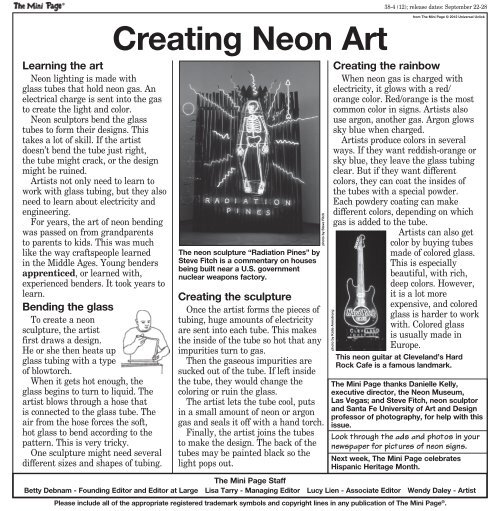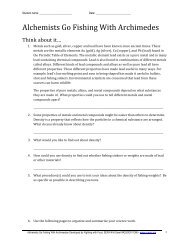September 22 - Newspapers In Education
September 22 - Newspapers In Education
September 22 - Newspapers In Education
- No tags were found...
Create successful ePaper yourself
Turn your PDF publications into a flip-book with our unique Google optimized e-Paper software.
®38-4 (12); release dates: <strong>September</strong> <strong>22</strong>-28from The Mini Page © 2012 Universal UclickLearning the artNeon lighting is made withglass tubes that hold neon gas. Anelectrical charge is sent into the gasto create the light and color.Neon sculptors bend the glasstubes to form their designs. Thistakes a lot of skill. If the artistdoesn’t bend the tube just right,the tube might crack, or the designmight be ruined.Artists not only need to learn towork with glass tubing, but they alsoneed to learn about electricity andengineering.For years, the art of neon bendingwas passed on from grandparentsto parents to kids. This was muchlike the way craftspeople learnedin the Middle Ages. Young bendersapprenticed, or learned with,experienced benders. It took years tolearn.Bending the glassTo create a neonsculpture, the artistfirst draws a design.He or she then heats upglass tubing with a typeof blowtorch.When it gets hot enough, theglass begins to turn to liquid. Theartist blows through a hose thatis connected to the glass tube. Theair from the hose forces the soft,hot glass to bend according to thepattern. This is very tricky.One sculpture might need severaldifferent sizes and shapes of tubing.Creating Neon ArtThe neon sculpture “Radiation Pines” bySteve Fitch is a commentary on housesbeing built near a U.S. governmentnuclear weapons factory.Creating the sculptureOnce the artist forms the pieces oftubing, huge amounts of electricityare sent into each tube. This makesthe inside of the tube so hot that anyimpurities turn to gas.Then the gaseous impurities aresucked out of the tube. If left insidethe tube, they would change thecoloring or ruin the glass.The artist lets the tube cool, putsin a small amount of neon or argongas and seals it off with a hand torch.Finally, the artist joins the tubesto make the design. The back of thetubes may be painted black so thelight pops out.Creating the rainbowWhen neon gas is charged withelectricity, it glows with a red/orange color. Red/orange is the mostcommon color in signs. Artists alsouse argon, another gas. Argon glowssky blue when charged.Artists produce colors in severalways. If they want reddish-orange orsky blue, they leave the glass tubingclear. But if they want differentcolors, they can coat the insides ofthe tubes with a special powder.Each powdery coating can makedifferent colors, depending on whichgas is added to the tube.Artists can also getcolor by buying tubesmade of colored glass.This is especiallybeautiful, with rich,deep colors. However,it is a lot moreexpensive, and coloredglass is harder to workwith. Colored glassis usually made inEurope.The Mini Page StaffBetty Debnam - Founding Editor and Editor at Large Lisa Tarry - Managing Editor Lucy Lien - Associate Editor Wendy Daley - ArtistPlease include all of the appropriate registered trademark symbols and copyright lines in any publication of The Mini Page ® .photo by Steve Fitchphoto by Katie ArmstrongThis neon guitar at Cleveland’s HardRock Cafe is a famous landmark.The Mini Page thanks Danielle Kelly,executive director, the Neon Museum,Las Vegas; and Steve Fitch, neon sculptorand Santa Fe University of Art and Designprofessor of photography, for help with thisissue.Look through the ads and photos in yournewspaper for pictures of neon signs.Next week, The Mini Page celebratesHispanic Heritage Month.
















